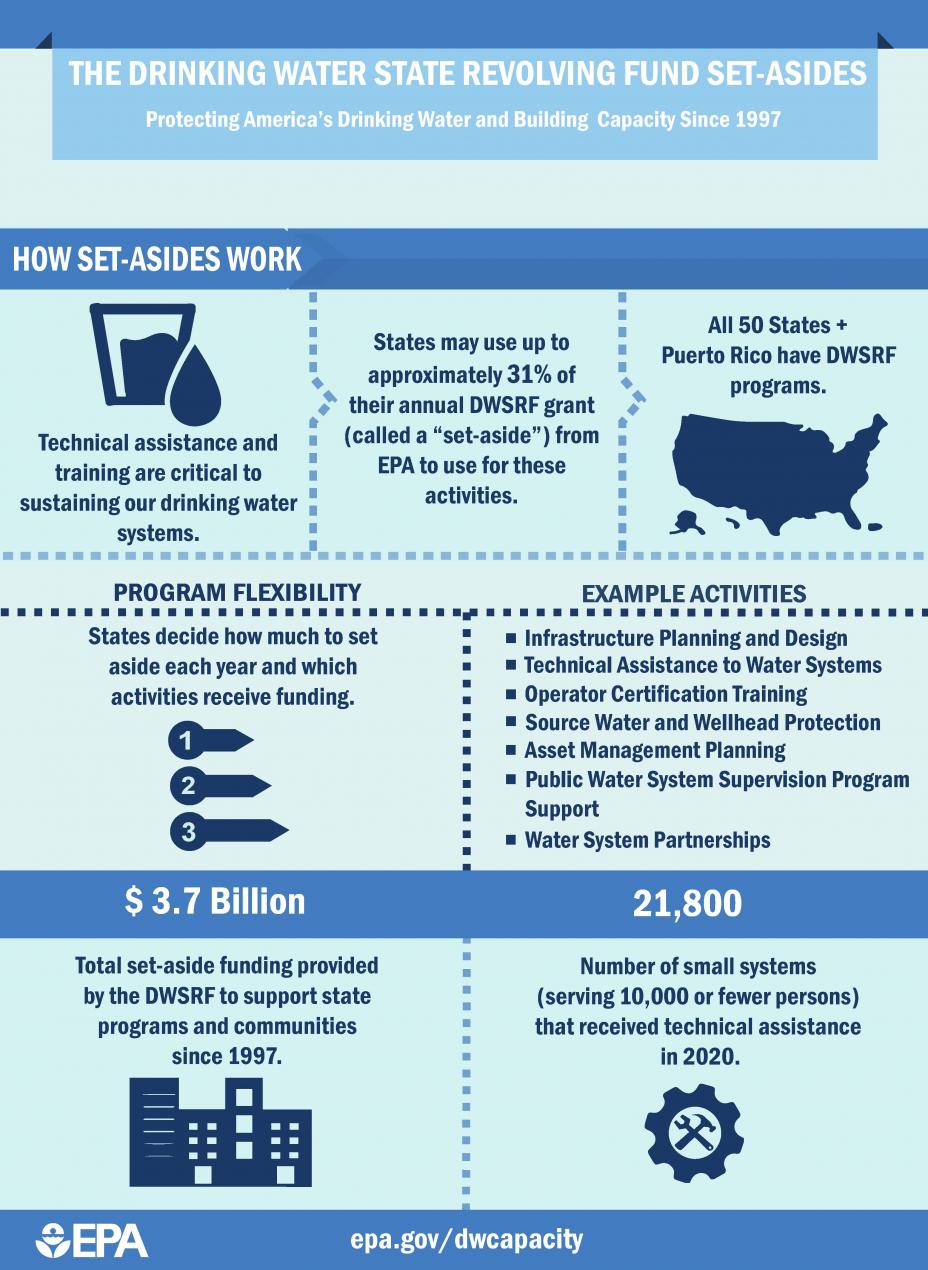About the Drinking Water State Revolving Fund (DWSRF) Set-Asides
On this page:
What is the Drinking Water State Revolving Fund?
The DWSRF is a federal-state partnership through which a perpetual drinking water infrastructure revolving loan fund is maintained in each of the 50 states and Puerto Rico. The federal government provides capitalization grants to states, and states must provide a 20 percent match for those grants. Loans are made to public water systems (PWSs) from these funds, and over time, as these loans are repaid to the state and interest is earned, the state makes new loans from these perpetual “revolving” funds.
Recognizing that not all drinking water problems can be solved through new or improved infrastructure, the SDWA allows states to take a portion of their annual capitalization grant to support water system capacity, operator certification, source water protection, training and technical assistance to PWSs. States have the discretion to take up to approximately 31 percent of their capitalization grant for set-asides and can use these funds to hire state staff or to contract with third party technical experts. Cumulatively, states have used only half of the allowable amount.
Cumulatively, states have used only half of the allowable amount. In 2019, states took a higher percentage of set-asides than their historical average in all four categories.
Additional information on the Drinking Water State Revolving Fund is available here.
DWSRF Set-Asides
-
Administration and Technical Assistance (the greater of 4 percent, $400,000, or 1/5th percent of the current valuation of the fund);
-
Small System Technical Assistance (2 percent);
-
State Program Management (10 percent); and
-
Local Assistance and Other State Programs (15 percent).
-
Providing states with flexible tools to assist water systems with training, technical assistance and pre-construction activities; and
-
Extending and enhancing the impact of DWSRF funding by ensuring that water systems have the technical, managerial and financial capacity to obtain a loan and to effectively maintain their resources.
| General Activities Funded by Set-Asides | General Activities NOT Funded by Set-Asides |
|---|---|
|
|
Administration and Technical Assistance - Greater of 4 percent, $400,000, or 1/5th percent of the current valuation of the fund
The Administration and Technical Assistance set-aside allows states to use up to 4 percent of the capitalization grant, $400,000, or 1/5th percent of the current valuation of the fund (whichever is greater). This set-aside is used for costs associated with administering and implementing the state’s DWSRF Program and providing technical assistance to systems of all sizes.
Most states reserve this set-aside to cover a portion of the loan program administration costs that can include direct technical assistance to water systems in completing DWSRF loan applications. While this set-aside has been typically used only for state program administration, there is an opportunity to support technical assistance to water systems serving more than 10,000 persons.
Small System Technical Assistance - 2%
Small water systems – PWSs serving 10,000 or fewer persons – typically face greater challenges than larger systems due to limited economies of scale. This set-aside allows states to use up to 2 percent of the capitalization grant to provide technical assistance and training to help small systems build the capacity they need to provide safe drinking water.
States provide technical assistance to small water systems, including assistance in planning new infrastructure projects, payments to third-party technical assistance providers and specialized small system training.
State Program Management - 10%
The State Program Management set-aside allows states to use up to 10 percent of their annual allotment to:
- Develop and implement water system Capacity Development and Operator Certification Programs
- Administer Source Water Protection Programs
- Support other state drinking water program activities.
There is a broad range of eligible activities for administering and implementing the state PWSS Program.
Local Assistance and Other State Programs - 15%
The Local Assistance and Other State Programs set-aside allows states to use up to 15 percent of their annual capitalization grant to assist in the development and implementation of local drinking water initiatives and other state programs, (e.g., capacity development and source water protection).
This set-aside can also be used for direct financial assistance to water systems. A maximum of 10 percent out of the 15 percent set-aside funds can be spent on any single effort. An advantage of this set-aside is that source water and wellhead protection activities are more broadly defined compared to the State Program Management set-aside requirements.
Examples of activities include:
- Developing and implementing asset management plans for communities.
- Providing grants to systems considering regionalization or consolidation.
- Providing loans for the implementation of source water quality protection efforts.

